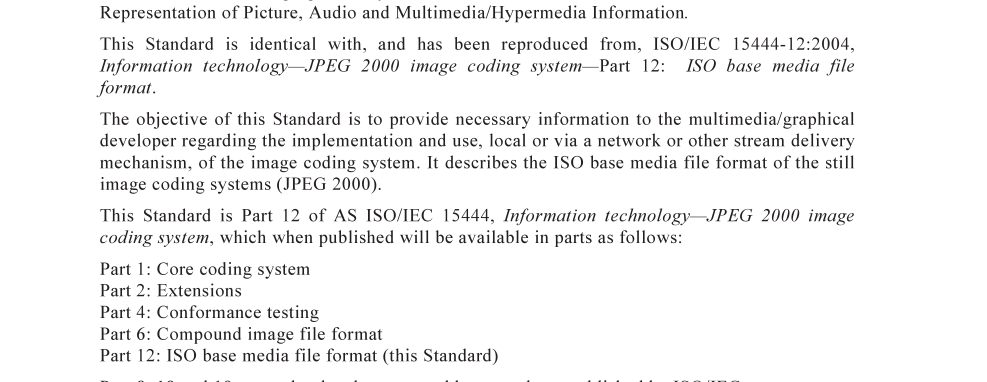AS ISO IEC 15444.12:2004 pdf download – Information technology—JPEG 2000 image coding system Part 12: ISO base media file format.
1 Scope This International Standard specifies the ISO base media file format, which is a general format forming the basis for a number of other more specific file formats. This format contains the timing, structure, and media information for timed sequences of media data, such as audio/visual presentations. This part of ISO/IEC 15444 is applicable to JPEG 2000, but its technical content is identical to that of ISO/IEC 14496-12, which is applicable to MPEG-4. 2 Normative references The following referenced documents are indispensable for the application of this document. For dated references, only the edition cited applies. For undated references, the latest edition of the referenced document (including any amendments) applies. ISO 639-2:1998, Codes for the representation of names of languages — Part 2: Alpha-3 code ISO/IEC 11578:1996, Information technology — Open Systems Interconnection — Remote Procedure Call (RPC) ISO/IEC 14496-1:2001, Information technology — Coding of audio-visual objects — Part 1: Systems 1) ITU-T Rec.T.800 | ISO/IEC 15444-1, Information technology — JPEG 2000 image coding system: Core coding system 3 Terms and definitions For the purposes of this document, the following terms and definitions apply. 3.1 Box An object-oriented building block defined by a unique type identifier and length (called ‘atom’ in some specifications, including the first definition of MP4). 3.2 Chunk A contiguous set of samples for one track. 3.3 Container Box A box whose sole purpose is to contain and group a set of related boxes.
3.4 Hint Track A special track which does not contain media data. Instead it contains instructions for packaging one or more tracks into a streaming channel. 3.5 Hinter A tool that is run on a file containing only media, to add one or more hint tracks to the file and so facilitate streaming. 3.6 Movie Box A container box whose sub-boxes define the metadata for a presentation (‘moov’). 3.7 Media Data Box A container box which can hold the actual media data for a presentation (‘mdat’). 3.8 ISO Base Media File The name of the file format described in this specification. 3.9 Presentation One or more motion sequences (q.v.), possibly combined with audio. 3.10 Sample In non-hint tracks, a sample is an individual frame of video, a time-contiguous series of video frames, or a time-contiguous compressed section of audio. In hint tracks, a sample defines the formation of one or more streaming packets. No two samples within a track may share the same time-stamp. 3.11 Sample Description A structure which defines and describes the format of some number of samples in a track. 3.12 Sample Table A packed directory for the timing and physical layout of the samples in a track. 3.13 Track A collection of related samples (q.v.) in an ISO base media file. For media data, a track corresponds to a sequence of images or sampled audio. For hint tracks, a track corresponds to a streaming channel. 4 Object-structured File Organization 4.1 File Structure Files are formed as a series of objects, called boxes in this specification. All data is contained in boxes; there is no other data within the file. This includes any initial signature required by the specific file format. All object-structured files conformant to this section of this specification (all Object-Structured files) shall contain a File Type Box.
AS ISO IEC 15444.12:2004 pdf download – Information technology—JPEG 2000 image coding system Part 12: ISO base media file format






